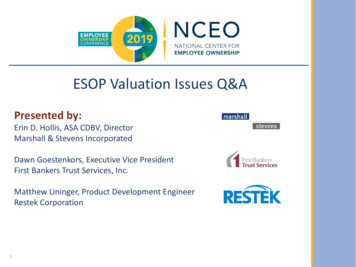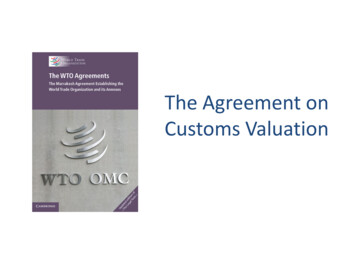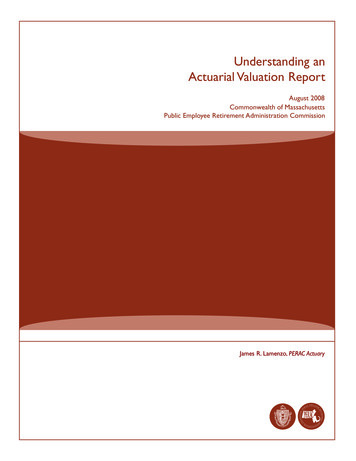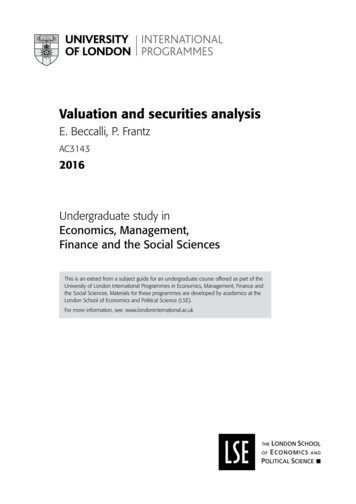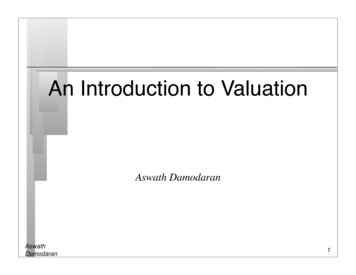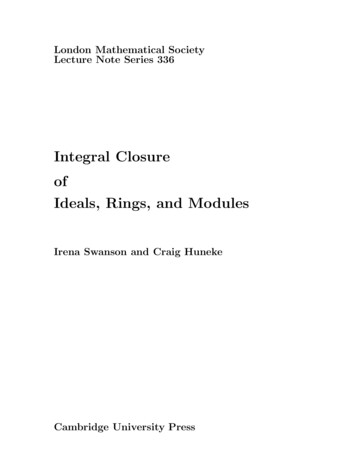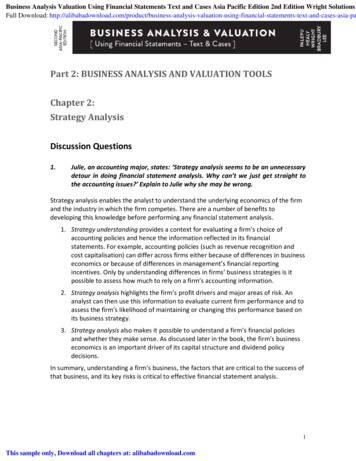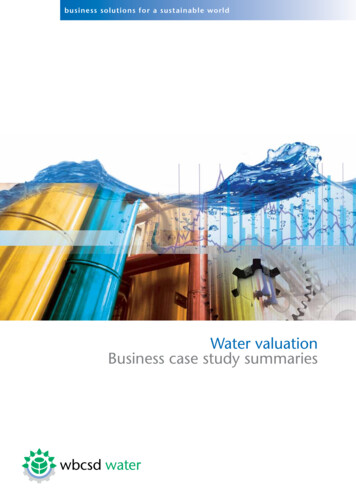
Transcription
business solutions for a sustainable worldWater valuationBusiness case study summaries
2Water valuation : Business case study summaries
Introduction and acknowledgmentsThis compendium of case studies is a companion document to the Water valuation : Building the business casepublication. It illustrates how and why different companies have carried out water-related valuation studies, andis based on publicly information available.Our special thanks go to WBCSD member companies featured in the two sets of publications, Water Valuation :Building the business case and Water Valuation : Business case study summaries : Anglo American, The DowChemical Company, EDF, Energias de Portugal, Hitachi, Holcim, Lafarge, Mondi, PUMA, Rio Tinto, Veolia andXylem (previously ITT). We are also extremely grateful to BCSD Portugal, ERM, Sustain Value, US BCSD and PwCfor helping us collect additional examples of corporate valuation studies and providing valuable insights.1. Anglo AmericanCost analysis for operationalsustainabilityAnglo American, with the assistance of ERM, used acost-based approach to unlock financial value relatingto the integration of safety and sustainability issueswithin Anglo’s asset optimization program. The aimwas to develop a methodology to be used duringoperational reviews to identify where cost savingscould be made for a set of key parameters. Water, asone of the parameters, was assessed in terms of its fullfinancial cost to obtain and its availability. The mainbusiness case argument was to identify potential costsavings, but the results showed that it also providedadded value as a result of bringing company expertsfrom various disciplines together to determine thevalues at stake rather than to work in silos.The approach used “value driver trees”, a form offinancial cost analysis that separates out the differentcost elements relating to each parameter. For water,this considered costs and revenues associated withthe use of grey, green, blue and seawater. The resultsrelating to water are not publically available.Weblink for additional information2. AntofagastaValuation tool to assessrisks, opportunities andenvironmental valuesAntofagasta, with the assistance of Sustain Value,is developing a combined Corporate EcosystemServices Review (ESR) and Corporate EcosystemValuation (CEV) tool to be applied to their miningoperations in Chile and elsewhere. The overall aimis to develop a tool that could on the one hand helpidentify and manage potential environmental risks andopportunities, and on the other, determine whethercompany operations and projects are creating netenvironmental value, which is a company goal. Theinitial assessment stage determines qualitativevalues for water, while the more detailed assessmentpotentially determines monetary values for water, aswell as for various other ecosystem services and otherenvironmental externalities. The values are basedon the financial and societal impact that companyoperations cause to different stakeholder groups.The main business case arguments are to helpmanage risks and opportunities and to enhance thecompany’s reputation by helping to ensure that thecompany creates an overall net environmental gain.The approach adopted for the qualitative assessmentof value (i.e. high, medium and low) is based onprofessional judgment and consensus, while anypotential monetary valuations are likely to be basedon benefit (value) transfers. The results are currentlybeing determined.Additional information:Not yet available.Water valuation : Business case study summaries3
3. The Dow Chemical CompanyDeveloping tools to integrateecosystem values inmanufacturing plant designand operationsDow, with the support of The Nature Conservancy(TNC) is, over a 5 year period, developing anapproach to valuing ecosystem services to apply totheir global operations, initially using three pilot sites.The aim of the first pilot, at Dow’s Texas operationsin Freeport, is to identify the critical ecosystemservices at the site for the business and to evaluatealternative scenarios for managing associated risks andopportunities using the Corporate Ecosystem ServicesReview (ESR), and valuation and cost-benefit analysis.Freshwater is one of the three critical ecosystemservices identified at the first pilot site, and its valueto stakeholders under different scenarios will beassessed. Water quality improvements may also be anancillary benefit from large-scale tree planting to dealwith air quality mitigation. The main business casearguments are to help deliver new practices to solvebusiness and conservation issues, identify project levelcost savings, and provide additional societal benefits.The approaches to be used for valuation have yet tobe determined. The results are not yet available.Weblink for additional information4. EDFWater valuation to optimizewater use in the Durance Valley,FranceEDF used water valuation to help the decisionmaking process for optimal water management in thewatershed along the 250km River Durance, in SouthEast France, with respect to competing multipurposeuses of water. These include agriculture, tourism(fishing, swimming, sailing, etc.), hydropower,drinking water and flood control. The overall aimwas to optimize water allocation between energygeneration and irrigation and to develop appropriateincentives for water savings in order to restorefinancial margins, and answer to future water demandfrom other users. The value used for water was theenergy cost ( /KWh) based on current and futureprices in France and linked to the energy productivity(m3/KWh) and the volume of water used (m3) bythe hydropower plant. The main business caseargument for the valuation study was to clearlydemonstrate the benefits of optimizing water uses foreach party and to define the level of remunerationfor this savings. The approach adopted was toimplement a Water Saving Convention, signed by EDFand the two main irrigators, for a six-year period withthe possibility to adjust it if it achieved better resultsthan expected. To balance these efforts, EDF has acommitment to remunerate the partners for theirsavings. The deal was so effective that a first additionalagreement was signed in 2003 and a second one in2006 to increase the savings target from 44 to 65 andthen to 90 million cubic meters, showing a decreasein agricultural consumption from 310 million cubicmeters in 1997 to 201 million cubic meters in 2005.The results showed that in addition to simply thevolume of water saved, a key benefit was the timingof the water savings because the saved water couldbe used to generate more electricity during peakperiods of electricity demand when electricity pricesare higher. Both parties come out ahead, with a thirdwinner being ecosystems as around 84% of the watersavings are used for ecological purposes.Weblinks for additional information:EDF website and Durance Valley website4Water valuation : Business case study summaries
5. Energias de Portugal (EDP)Corporate Ecosystem Valuationfor hydropower managementin PortugalEDP, with the support of the WBCSD and severalPortuguese universities, undertook a CorporateEcosystem Valuation (CEV) to explore the ecosystemservice values associated with the management of ahydropower facility within a watershed in Portugal.The aim of the study was to assess the financial andsocietal benefits provided as a result of maintainingthe hydropower facility. The values assessed inrelation to water included the financial value ofwater supplies for human consumption and irrigation,and the societal value of recreational fishing on thereservoirs. The business case arguments includedlearning about ecosystem valuation in anticipationof it being a future requirement, potentially usingthe results for future financial securities negotiationsunder the EU Environmental Liability Directive,and being able to promote greener EU RenewableEnergy Certificates. The valuation approach usedfor the water supply benefits was a market pricebased approach (m3 of water multiplied by the watertariff minus operational costs), while for recreationalfishing values, a travel cost approach was used(based on angler license fees plus average travelcosts). The results underline the importance thishydropower system has for society when comparingthe total economic value (TEV) of the watershedbetween two scenarios – “with” and “without” thehydropower system. In the “with” scenario, the TEVof the hydropower system is higher and only 30% isrepresented by EDP’s financial benefits. In contrast,the “without” scenario shows a 92% decrease in TEV,highlighting the importance of how EDP manages thefacility and site for the region.6. Esporão SAValuing water-cost savingsto enhance wine productionefficiencyEsporão SA used a water valuation approachto determine the extent of cost savings fromimplementing a water reduction managementstrategy for their wine production operations inPortugal. The main concern in reducing water usagehas to do with environmental awareness of thescarcity of water. The overall aim was to monitor thefinancial implications of their pursuit to reduce thevolume of water used per bottle of wine produced.The value used for water was the financial cost(i.e. market price) of water, in this case based on 2.30/m3. The main business case argument forthe valuation study was to better focus where watersavings could be found and to determine the levelof associated financial cost savings. However, thestudy also led to additional benefits associated withimproved collaboration between company staff atall levels, and by informing stakeholders about theimportance and value of water use and associatedbusiness risks. The approach adopted was simply toapply a financial value (i.e. market price) of water percubic meter to the volume of water saved for a rangeof different technologies and actions to reduce waterconsumption. No recognition of value (qualitative ormonetary) was given to the additional social valuegained as a result of using less water. The resultshave allowed Esporão to reduce water consumptionby 30% so far, saving 10 million liters of water in oneyear. The amount of water used to produce 1 liter ofwine has been reduced from 2.8 liters to 1.7 liters. Tosummarize, the water savings were due to: a changein cleaning procedures, equipment modifications,training, careful monitoring, and controlling leakage.Weblink for additional informationWeblink for additional informationWater valuation : Business case study summaries5
7. HitachiCorporate Ecosystem Valuationfor water supply and treatmentin the Maldives8. HitachiCorporate Ecosystem Valuationfor precision agriculture ITsolutions in the US and FranceHitachi undertook a Corporate Ecosystem Valuation(CEV) study, supported by ERM and Sustain Value, fora new water supply and water treatment plant usingreverse osmosis technology and a new gas-fired powersupply in Male, the Maldives, and its surroundingislands. The overall aim was to quantify and monetizethe financial and societal costs and benefits associatedwith the schemes, in particular focusing on theenvironmental impacts. Water was valued in termsof the financial value that would be generated fromsupplying and selling water (i.e. based on price/tariffs). Other environmental impacts were monetizedas societal values, which included societal benefitsfrom reduced air emissions (NOx, SOx and particulatematter) and greenhouse gas emissions, and societalcosts due to construction works damaging coralreefs. The main business case arguments for Hitachiwere to better understand the potential applicationsand advantages of applying a CEV, and to enhanceproject sustainability by considering environmentalimpacts from a stakeholder value and monetaryperspective at the planning stage. The study usedmarket prices for the financial value of water, andbenefit (value) transfers and replacement costs toestimate environmental impacts. The quantificationof air emissions and greenhouse gases drew upon lifecycle assessments to account for both constructionand operational impacts. The results showed thatthe proposed scheme is viable from both a financialand societal perspective, with a 30-year economicbenefit-to-cost ratio of 2:3 when societal impacts areincluded.Hitachi undertook a Corporate EcosystemValuation (CEV) study, supported by ERM andSustain Value, that assessed the potential benefitsthat could be gained by farmers, agriculturalcooperatives/organizations and society as a whole ifthey used GeoMation Farm technology, a geographicinformation system (GIS), to implement precisionagriculture on farms in the US and France. The overallaim was to quantify and monetize the potentialfinancial and societal benefits relating to reducedinputs and pollution and enhanced crop productivityfor corn, wheat and soybeans for an average farmin each country. The potential financial and societalvalue of reduced water consumption was assessed.Benefits were also assessed for reduced nitrogen andpesticide use and pollution. The main business casearguments for Hitachi were to better understand thepotential applications and advantages of applying aCEV, and to inform the development and marketing ofthis product in the two targeted countries.The study used market prices for the financial valuesand benefit (value) transfers for the societal valuesbased on a thorough literature review of precisionagriculture improvements and environmental values.The results revealed which environmental parametersare likely to be of most interest in the US and France,and indicated that using GeoMation Farm couldpotentially yield significant financial returns to farmersand agricultural cooperatives/organizations fromincreased crop production and modest financial costsavings from reduced inputs. They also indicated thatsociety would gain significant benefits from reducedwater use and nitrate pollution.Additional information:Not yet available6Water valuation : Business case study summariesAdditional information:Not yet available
9. Holcim /Aggregates Industries UKCorporate Ecosystem Valuationfor quarry rehabilitation inEnglandAggregates Industries UK, a subsidiary of Holcim,with the support of the International Union forConservation of Nature (IUCN), conducted aCorporate Ecosystem Valuation (CEV) to better informthe rehabilitation plan for a proposed extensionto a sand and gravel mine in Ripon as part of theUK permitting process. The aim was to quantify inmonetary terms the impacts that the quarrying andrestoration operations (wetland and lake creation)would have on biodiversity and the ecosystem servicesprovided to local communities and the region.Water was relevant to the valuation in relation to thecreation of a wetland habitat, a recreational lake, andthe provision of flood storage capacity. The mainbusiness case arguments included demonstratingoverall community benefit to gain better access tominerals in the future, saving costs relating to this andfuture planning procedures, and developing a tool toenhance decision-making with respect to biodiversityand local livelihoods. The valuation approachadopted was a benefit (value) transfer drawing uponstated preference survey results and meta-analysesfor similar impacts and values elsewhere in the UK.The study estimated biodiversity benefits from theproposed wetlands of 1.4 million, recreationalbenefits of the proposed lake of 350,000, andincreased flood storage capacity of the overallarea of 224,000. After deducting restoration andopportunity costs, this would deliver net benefits tothe local community of about 1.1 million (in presentvalue terms) over a 50-year period.10. ITT / XylemStated preference valuation foran improved water supply inthe USITT (now Xylem) undertook a willingness to paysurvey targeted at the general public and agriculturaland industrial businesses throughout the US toexplore their views and preferences on watermanagement and supply. The overall aim was toobtain quantitative information on their views and, inparticular, to elicit how much they were willing to payfor improved water infrastructure to ensure long-termaccess to clean water. The value elicited represents thepotential additional economic value that consumerswould gain from an improved water supply, whichthey would in theory be happy to pay (it wouldbecome a “financial” value if they then had to paythat amount). The main business case argument wasto demonstrate the demand from both the US publicand businesses to justify to the government the desirefor greater spending on water infrastructure, as this isa product that ITT provides. The approach adoptedwas a contingent valuation (stated preference) surveycompleted by 1,050 general public and 550 businessrespondents. The results revealed that two-thirdsof US respondents are willing to pay an average ofUS 6.20 per month more than they currently pay,representing US 5.4 billion a year (four times currentfederal investment). Fifty-seven percent (57%) ofbusinesses were willing to pay 7% more than theycurrently do.Weblink for additional informationWeblink for additional informationWater valuation : Business case study summaries7
11. Kraft Foods/Tsb Sugar12. LafargeSupply chain ecosystem services Corporate Ecosystem Valuationrisks and opportunity valuation for quarry reclamation in the UStoolKraft Foods, with the assistance of ERM and SustainValue, is developing a supply chain ecosystem servicesrisk and opportunity valuation tool, which is beingpiloted at one of Tsb Sugar’s sugar cane plantations inSouth Africa, with their support. The overall aim is todevelop an approach that can assist Kraft Foods andits suppliers to manage potential ecosystem servicerisks and opportunities as effectively as practicableto help secure a sustainable supply of commoditiesfor the future. The values determined for water areboth qualitative and monetary, and are based on thepotential risks and opportunities that may occur bothwith and without management actions put in place.These relate to issues such as floods and droughtsexacerbated by climate change, payments forecosystem services, and increased water prices. Themain business case arguments are to enhance thereputation for sustainability of both Kraft Foods and itssuppliers, to better manage supplier ecosystem servicerisks, to evaluate potential new revenue streams,and to develop more robust long-term partnershipsbetween Kraft Foods and suppliers to secure suppliesand reduce costs. The approach adopted is both aqualitative assessment of value (i.e. high, medium andlow) based on professional judgment and a monetaryvaluation based primarily on change in productivity.The results are currently being determined.Additional information:Not yet available8Water valuation : Business case study summariesLafarge, with support from the World ResourcesInstitute (WRI), the World Wide Fund for Nature(WWF) and the Wildlife Habitat Council (WHC),conducted a Corporate Ecosystem Valuation (CEV)to enhance its land management planning forthe future reclamation of a quarry in Presque Isle,Michigan, US. The aim of the study was to identifythe main ecosystem services of relevance and toinform mining design and reclamation. The valuesassessed in relation to water were erosion control(to avoid sedimentation costs) and water purification(i.e. retaining nutrients). Recreational values (fishing,hunting and wildlife viewing) were also assessed.The business case arguments included cost savings,optimizing societal benefits, enhancing the company’sland asset values, and developing experience in CEVto use for other applications. The valuation approachused the InVEST model to determine avoided costsof sedimentation from erosion control and avoidedcosts of nutrients retained by vegetation. The resultspredicted avoided societal costs of US 2 million peryear for erosion control and US 50,000 per year fornutrient retention.Weblink for additional information
13. Maryland State WaterQuality Advisory CommitteeEconomic impact assessmentand willingness to pay for riverquality improvements in the USThe Maryland State Water Quality AdvisoryCommittee, with the support of DownstreamStrategies, undertook an economic impact assessmentand willingness to pay survey of the benefits from acidmine drainage remediation relating to abandonedcoal mines on the North Branch Potomac River.The aim of the study was to determine what the localeconomic benefits are in the region relating to theriver to inform decisions about future funding so thatremediation of the river can continue. The benefitsassessed relate to improving river water quality inrelation to angling and boating expenditures, knockon economic impacts, and additional willingness topay for enhanced recreational experiences at the site.The business case arguments for doing the studywere to justify continued levels of funding to ensureacid mine pollution does not pollute the river again.The valuation approaches used were primarily visitorexpenditure and willingness to pay questionnaires,with 306 anglers and 79 boaters completing thesurveys. This was supplemented by the use of IMPLANsoftware to calculate additional spending andemployment effects. The results revealed substantialeconomic benefits from the remediation based onanglers and boaters currently spending US 2.1million per year in two local counties, with additionalknock on expenditures of US 0.9 million. Overall, thisresults in around 40 full-time equivalent jobs and US 266,000 in state and local taxes. Anglers and boatersare also willing to pay an additional US 4.1 millionper year for existing recreational experiences (i.e. thisrepresents additional existing societal value arisingfrom the remediation).14. Minera Escondida LimitadaMarginal Abatement Cost Curvefor mining water abatement inChileMinera Escondida Limitada (BHP Billiton), with thesupport of PwC, undertook a Marginal AbatementCost Curve (MACC) assessment of water consumptionat a large mine in the Atacama Desert in Chile.The aim of the study was to identify potentialprojects that are the most cost-effective in termsof reducing consumption of high-quality water(HQW) at the mine. The values assessed are the netfinancial costs (or savings) per cubic meter of waterconsumption avoided. The business case argumentsare based on finding the lowest cost means forthe company to reduce water consumption, plusdemonstrating to stakeholders that the companyis doing what it can to reduce the use of a scarceresource. The MACC valuation approach assessesthe financial implementation costs (i.e. capital andoperational costs) less any financial cost savings (suchas from reduced water and energy consumption),divided by the volume of water consumption (in m3)reduced by that project, for a set of projects.The results showed that the financial cost of reducingwater consumption varied from a savings of US 30per cubic meter to a cost of US 50 per cubic meterdepending on the project.Additional information:Not yet availableWeblink for additional informationWater valuation : Business case study summaries9
15. MondiCorporate Ecosystem Valuationfor water use in a catchment inSouth AfricaMondi, with the support of the World ResourcesInstitute, conducted a Corporate Ecosystem Valuation(CEV) to explore the financial value of water use in theMhlatuze catchment in South Africa. The aim of thestudy was to better understand the different users andvalues in a water catchment area using GIS (globalinformation systems) to help inform Mondi’s futureforestry and water-related management decisions.The value assessed in relation to water was thefinancial value of water consumption by differentuser groups. The business case arguments includedresource efficiency in terms of data managementusing GIS, sustaining revenues by reducing futureoperational risks from potential water shortages,and helping to optimize societal benefits throughimproved coordination and planning for water useby all users. The valuation approach used was basedon the market price of water (i.e. the volume of waterin cubic meters used multiplied by the tariff price foreach sector). The results showed that, based on thedata collected (which was not complete), forestryplantations paid 26 million Rand (at 0.38 Rand/m3),irrigation (mainly sugar cane) paid 41 million Rand(at 0.70 Rand/m3), and urban/industrial users paid 69million Rand (at 0.81 Rand/m3).Additional information:WBCSD Guide to Corporate Ecosystem Valuation10Water valuation : Business case study summaries16. PUMAEnvironmental profit and lossaccount and global water valuesPUMA, with the assistance of Trucost and PwC,developed an environmental profit and loss accountthat ultimately aims to include the societal costs ofenvironmental and social impacts for their entireglobal supply chain (i.e. internalize externalities).The aim of the initial stage was to quantify thesocietal costs of greenhouse gases and water inmonetary terms. Water was valued in terms of per cubic meter of water consumed based on thereduced indirect use value accruing to third parties,such as from freshwater replenishment, ecosystemmaintenance and water nutrient cycling. The mainbusiness case arguments include global recognitionand reputational benefits gained, being able tohelp influence the methodology used, which mayeventually be adopted by others, and gaining adetailed understanding of the relative significanceof the different impacts their products have alongthe supply chain. The approach adopted for thevaluation is value (benefit) transfer, using a slidingscale of values per cubic meter for water, based on thesocietal costs of using water and its relative scarcityat a local or national level. The results revealed aweighted average value (i.e. societal cost) of 0.81/m3 water giving a total annual societal water costof 47.4 million for the global supply chain. Thisexternality cost is added into their environmentalaccounts as a notional “shadow price”.Weblink for additional information
17. Rio TintoCorporate Ecosystem Valuationfor forest biodiversity offsettingin Madagascar18. SA Water Corporation / GHDCorporate EcosystemValuation for water catchmentmanagement in AustraliaRio Tinto, with the support of the InternationalUnion for Conservation of Nature (IUCN), conducteda Corporate Ecosystem Valuation (CEV) study toexplore the economics of a rainforest biodiversityoffset in Madagascar as part of the company’s policyof net positive impact (NPI) on biodiversity at anoperational level. The study’s aim was to determinethe value of financial and societal costs and benefitsto different stakeholders from a proposed offsettingscheme involving the conservation of 60,000hectares of low-land rainforest. Water values wererelevant as an additional potential benefit arisingfrom forest conservation in the form of water supplyprovisions. The main business case argumentsincluded identifying the potential nature and extentof additional revenue streams (e.g. through ecosystemservice credits), improving stakeholder relations byensuring stakeholders are adequately compensated,and enhancing the company’s reputation by doingsuch studies and offsets. The approach used for thewater supply valuation was benefit (value) transferdrawing upon a previous willingness to pay survey inthe region for household water and linking the watersupply to the amount of forest area protected in thewatershed. The results of the water supply valuationwere that present value water supply benefits over 20years could be around US 200,000 based on a valueof US 1.7/ha. This value contributed to the overallestimated US 17 million net present value benefits(primarily carbon storage values) from proposed forestconservation.South Australian Water Corporation, with supportfrom GHD and the WBCSD, undertook a CorporateEcosystem Valuation (CEV) that assessed the valueof ecosystem services under several water catchmentmanagement options in Cox Creek, Australia. The aimof the study was to evaluate the financial and societalcosts and benefits associated with different catchmentmanagement activities, including, for example,creating sediment ponds and wetlands and improvingirrigation. The values assessed in relation to waterwere the financial returns from increased vegetableproduction and a reduction in water treatment costsfrom improved water quality regulation. The businesscase argument was predominantly the potentialcost savings from demonstrating that implementingcatchment management could be cheaper thanconventional water treatment. The valuationapproach used was change in productivity usingmarket prices for increased vegetable production andavoided costs for water treatment. The overall resultsdemonstrated the economic viability of improvedcatchment management with benefits of AUS 2.8million and costs of AUS 1.6 million (i.e. a benefit-tocost ratio of 1.7:1).Weblink for additional informationWeblink for additional informationWater valuation : Business case study summaries11
19. US Business Council forSustainable Development /Cook Composites and PolymersCorporate Ecosystem Valuationfor wetland construction in USAThe US Business Council for SustainableDevelopment (US BCSD) worked with CookComposites and Polymers (CCP) and Ohio StateUniversity, to undertake a Corporate EcosystemValuation (CEV) in relation to constructing a wetlandat CCP’s Houston facility to provide stormwaterprotection. The aim was to assess the financialand societal benefits associated with cost savingsand environmental improvements from the use ofa natural wetland system compared to renovatingthe existing man-made system. Water values wereassessed in terms of flood regulation and waterquality regulation benefits accruing from the wetland.The main business case arguments were thepotential to evaluate and justify financial savings,the demonstration of a positive contribution to thecommunity by creating a habitat and ecosystemservices, and the ability to help maintain
(i.e. market price) of water, in this case based on 2.30/m3. The main business case argument for the valuation study was to better focus where water savings could be found and to determine the level of associated financial cost savings. However,

